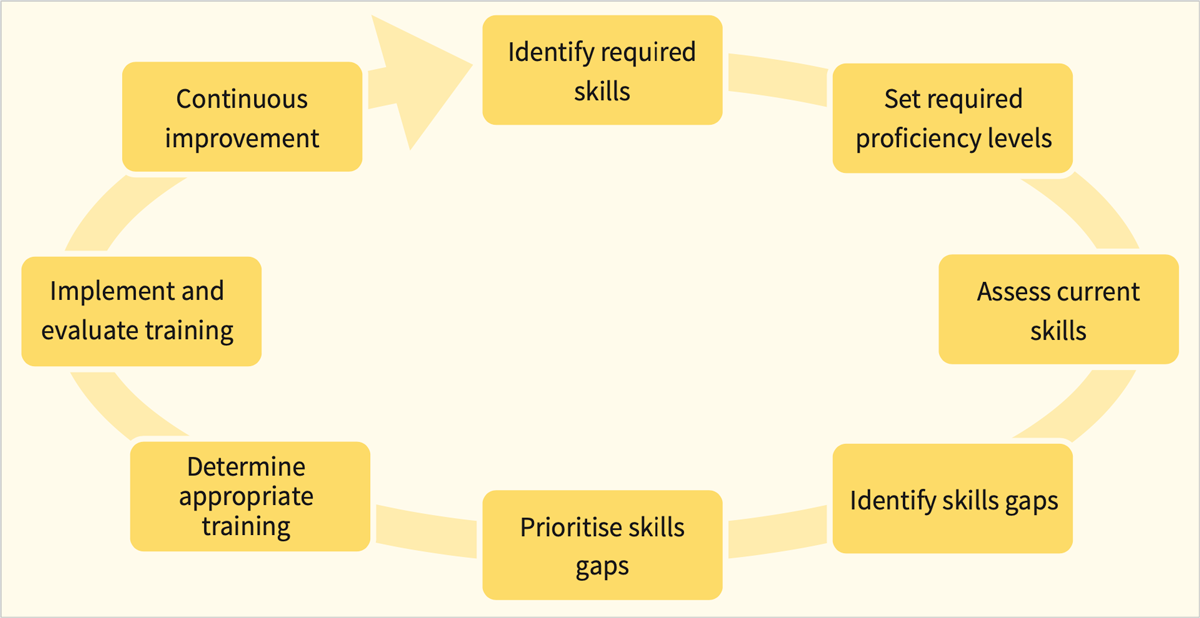1 Aug 2023
Running a successful veterinary practice requires a myriad of different skill sets and it can be a real headache identifying staff training needs. By using an analytical approach, however, finding training that boosts both your profits and your people can be a relatively painless process…

Image © Tupungato / Adobe Stock

Ongoing learning and skills development are crucial for all members of the practice team.
A skills gap analysis (Figure 1) aims to identify training needs by comparing the desired skill set for a particular role with the skills held, and can be completed for either individuals or groups.

The first step is to determine the skills actually required for the role. Some of these will be universal to all employees – communicating with clients, for example – and some will be very specific to particular roles. Senior staff will require skills in leadership, decision making or strategic thinking. Non-clinical staff will require a level of understanding of clinical matters: understanding veterinary terminology, for example, or recognising a potential emergency over the phone.
Next, decide on the level of proficiency required for each skill for that role. Using rating scales can help; for example, see Figure 2.
Evaluate the current skill level of the individual. This can be done using various methods, including supported self-reflection and performance review.
Compare the desired proficiency levels with the current skill levels and calculate the gaps between the two. These represent the skills that require improvement or further development.
Review the identified gaps and prioritise which need addressing first. Again, several tools are available to help with this – one to try is an Eisenhower matrix, where work is categorised according to its importance and urgency and actions determined.
| Not important | Important | |
| Urgent | Delegate | Do |
| Not urgent | Ditch | Diarise |
| Figure 3. Eisenhower matrix. | ||
Skills gaps that are both important and urgent should be prioritised for action (do). Skills gaps that are important but not urgent should be diarised for future action. Skills gaps that are urgent but not important should be considered for delegation; and those that are neither urgent nor important should be de-prioritised (and considered for ditching; Figure 3).
Once the skills gaps have been prioritised, co-create a plan to bridge the gaps. Ensure you consider all factors in deciding on the most appropriate means: individual preference, delivery style, cost, time, logistics, relevance, outcomes and impact will all be important. Set and agree success criteria.
Put the plan into action. Monitor progress by checking in regularly, seeking feedback, and making adjustments to the plan as needed.
Support a culture of continuous learning among the whole team. Regularly reassess skills and repeat the cycle to identify ongoing areas for development.
| Rating | Descriptor | Clinical example: monitoring anaesthesia |
Non-clinical example: processing payments |
| 1 | General understanding of the skill only | General understanding of anaesthesia (for example, an insurance claims manager who needs to understand what is involved, but does not actually carry out the skill) | General understanding of payment options (for example, a marketing manager who does not work on reception) |
| 2 | Can carry out the skill with guidance | Can manage simple anaesthesia for routine surgery alongside a colleague (for example, a student veterinary nurse who is learning from an experienced RVN) | Can process standard payments alongside a colleague (for example, a student veterinary nurse who is learning from an experienced receptionist) |
| 3 | Can carry out the skill independently | Can manage typical anaesthesia cases and respond to standard changes with confidence (for example, a qualified RVN) | Can process standard payments independently and deal with general payment queries with confidence (for example, an experienced RVN who covers reception occasionally) |
| 4 | Can handle complex situations and provide guidance to others | Can handle complex anaesthesia, respond to unexpected situations and manage challenging cases (for example, an experienced anaesthetist) | Can handle complex payments, answer challenging client queries and problem solve to find solutions to payment issues (for example, an experienced receptionist) |
| 5 | Mastery of the skill plus higher level/management responsibility | All the level four skills plus can set overall anaesthesia protocols for the practice (for example, the head of anaesthesia) | All the level four skills plus can set overall payment protocols and debt management strategies (for example, a senior accounts manager) |
| Figure 2. Examples of clinical and non-clinical proficiency scales. | |||
|---|---|---|---|
Once training objectives have been set, discuss with the individual and determine the most appropriate training to meet these goals. You will need to decide on in-house versus external provision, one to one versus group sessions, formal versus informal, in-person versus online, and so on.
Shadowing experienced employees and getting hands-on practice can be very effective for developing job-specific skills and provides real-world experience.
It can be a very rewarding experience for staff to be mentors, train new recruits and see them develop. However, such roles do require training for the mentor, and should always include a structured training plan to be effective.
Coaching can be an incredibly valuable form of personal and professional development.
Coaching is generally appropriate when someone needs support to reach a particular goal or develop a particular skill, and tends to be used over a set period. Group coaching is also possible.
The advantages of coaching are that it facilitates very personalised learning, and may be most appropriate for someone with specific goals, who prefers more conversational over didactic teaching, or who finds larger-scale training situations intimidating.
Formal class-based learning is relatively rare in today’s digital world. Staff may complete in-person qualifications or attend local evening classes in bookkeeping, customer service, or social media marketing.
The advantages of this type of training are that it is generally externally quality-assured, builds professional networks, and will lead to a recognised qualification or accreditation in a particular area of work.
In-person events can cover everything from local practices’ CPD evenings to national veterinary conferences. Smaller-scale events are more personal and more conducive to active learning. Larger events have the benefit of a range of topic options, as well as valuable networking opportunities, but tend to be more lecture based.
Wet labs are great ways to develop and practise clinical skills in a safe environment using simulations and mock-ups; workshops make the most of a smaller group setting to promote peer learning, active discussion and real-time feedback.
Online learning can also vary widely in scale, from one-off webinars to multi-year qualifications. The obvious advantage is that of accessibility: training can be accessed from anywhere with an internet connection, and often can be scheduled around work, home and family commitments. One-off sessions can be used to fill specific knowledge gaps or update people on the latest information available on a topic. Formal qualifications such as RCVS certificates or the VMG/ILM qualifications in Veterinary Leadership and Management can be studied mostly or entirely online, again offering significant accessibility and flexibility benefits.
When deciding on the right training to meet a skills gap, as many relevant factors as possible should be considered:
The key thing with identifying and meeting training needs is to make it a planned process.
It is easy to approach CPD by coming across a course that looks interesting, booking it, completing it and moving on to the next one. However, by being proactive about setting learning and development objectives, breaking down the skills needed and actively planning how those needs will be met, you can make your training much more effective, efficient, and enjoyable.